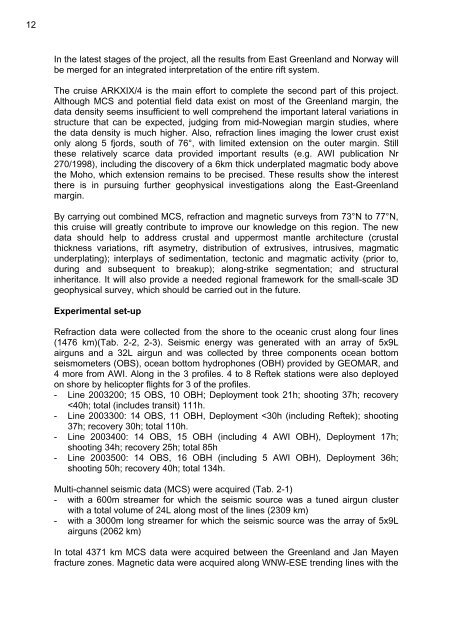the Expedition ARKTIS-XIX/4 of the research vessel POLARSTERN ...
the Expedition ARKTIS-XIX/4 of the research vessel POLARSTERN ...
the Expedition ARKTIS-XIX/4 of the research vessel POLARSTERN ...
Create successful ePaper yourself
Turn your PDF publications into a flip-book with our unique Google optimized e-Paper software.
12<br />
In <strong>the</strong> latest stages <strong>of</strong> <strong>the</strong> project, all <strong>the</strong> results from East Greenland and Norway will<br />
be merged for an integrated interpretation <strong>of</strong> <strong>the</strong> entire rift system.<br />
The cruise ARK<strong>XIX</strong>/4 is <strong>the</strong> main effort to complete <strong>the</strong> second part <strong>of</strong> this project.<br />
Although MCS and potential field data exist on most <strong>of</strong> <strong>the</strong> Greenland margin, <strong>the</strong><br />
data density seems insufficient to well comprehend <strong>the</strong> important lateral variations in<br />
structure that can be expected, judging from mid-Nowegian margin studies, where<br />
<strong>the</strong> data density is much higher. Also, refraction lines imaging <strong>the</strong> lower crust exist<br />
only along 5 fjords, south <strong>of</strong> 76°, with limited extension on <strong>the</strong> outer margin. Still<br />
<strong>the</strong>se relatively scarce data provided important results (e.g. AWI publication Nr<br />
270/1998), including <strong>the</strong> discovery <strong>of</strong> a 6km thick underplated magmatic body above<br />
<strong>the</strong> Moho, which extension remains to be precised. These results show <strong>the</strong> interest<br />
<strong>the</strong>re is in pursuing fur<strong>the</strong>r geophysical investigations along <strong>the</strong> East-Greenland<br />
margin.<br />
By carrying out combined MCS, refraction and magnetic surveys from 73°N to 77°N,<br />
this cruise will greatly contribute to improve our knowledge on this region. The new<br />
data should help to address crustal and uppermost mantle architecture (crustal<br />
thickness variations, rift asymetry, distribution <strong>of</strong> extrusives, intrusives, magmatic<br />
underplating); interplays <strong>of</strong> sedimentation, tectonic and magmatic activity (prior to,<br />
during and subsequent to breakup); along-strike segmentation; and structural<br />
inheritance. It will also provide a needed regional framework for <strong>the</strong> small-scale 3D<br />
geophysical survey, which should be carried out in <strong>the</strong> future.<br />
Experimental set-up<br />
Refraction data were collected from <strong>the</strong> shore to <strong>the</strong> oceanic crust along four lines<br />
(1476 km)(Tab. 2-2, 2-3). Seismic energy was generated with an array <strong>of</strong> 5x9L<br />
airguns and a 32L airgun and was collected by three components ocean bottom<br />
seismometers (OBS), ocean bottom hydrophones (OBH) provided by GEOMAR, and<br />
4 more from AWI. Along in <strong>the</strong> 3 pr<strong>of</strong>iles. 4 to 8 Reftek stations were also deployed<br />
on shore by helicopter flights for 3 <strong>of</strong> <strong>the</strong> pr<strong>of</strong>iles.<br />
- Line 2003200; 15 OBS, 10 OBH; Deployment took 21h; shooting 37h; recovery<br />

















